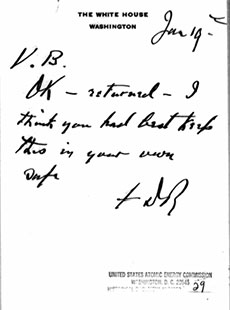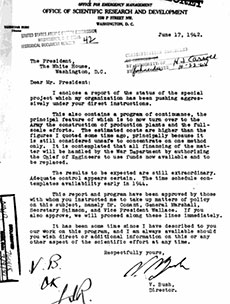Manhattan Project Mystery
By Cameron Reed, Department of Physics, Alma College, Alma, Michigan 48801 USA
For several years I have been researching the history and physics of the Manhattan Project, the United States' World War II-era effort to develop nuclear weapons. Copies of thousands of original Project documents are now readily available through the National Archives and Records Administration (NARA); users can request either microfilmed copies of sets of documents or pdf images recorded on a DVD. It can be fascinating to troll through these sources; on many occasions I have found myself reflecting on the idea that a document was at one time in the hands of President Roosevelt, Robert Oppenheimer, General Leslie Groves or some other Project leader. Sometimes one comes across a document that raises a minor historical mystery. My purpose in this brief article is to describe such a case.

Figure 1. January 19 or June 19?
On page 388 of his history of the Manhattan Project The Making of the Atomic Bomb, author Richard Rhodes reproduces a partially-dated handwritten note from President Franklin Roosevelt to Vannevar Bush that reads: "V.B. OK – returned – I think you had best keep this in your own safe FDR" (Figure 1). Bush was the Director of the wartime Office of Scientific Research and Development (OSRD), within which lay responsibility for investigating possible military applications of nuclear fission. Rhodes interprets the date of the note as January 19, 1942 and describes its context as the President returning to Bush a copy of a November 6, 1941 report on the possibilities of explosive fission with uranium-235. The report had been prepared by a committee chaired by University of Chicago physicist Arthur Compton and laid out in detail the physics of a fission bomb as well as estimates of the destructive action of such a weapon and the feasibility of various isotope separation methods. Bush discussed the report personally with FDR on Thursday, November 27 of that year – just about the time a Japanese task force was setting sail on its mission to attack Pearl Harbor. In their official history of the United States Atomic Energy Commission, historians Richard Hewlett and Oscar Anderson attribute the note to the same date and circumstance (their p. 49); their work is probably the source of Rhodes's later attribution.
While Roosevelt's note was not an official "go-ahead" for an American atomic-bomb project, its brevity and the authority conveyed by the scrawled initials give it a compelling sense of drama. Indeed, Hewlett and Anderson argue that the fundamental decision to proceed had occurred on October 9, 1941 when Bush had met with Roosevelt and Vice-President Henry Wallace to discuss a British report on the possibility of fission bombs as well as the need for post-war control of nuclear energy. At the October 9 meeting Roosevelt directed that discussion of policy issues was to be restricted to a group comprising himself, Bush, Wallace, Secretary of War Henry Stimson, Army Chief of Staff General George C. Marshall and James B. Conant, Bush's deputy at the OSRD. This group came to be known as the "Top Policy Group."

Figure 2. Letter from Vannevar Bush to President Roosevelt, June 17, 1942.
I suggest here, however, a strong possibility for a different date for Roosevelt's note. The note appears as image 0945.jpg of Reel 1 of NARA microfilm set M1392 ("Bush-Conant File Relating to the Development of the Atomic Bomb, 1940-1945"); it is one of a number of documents concerning Bush's reports to and conferences with the President. Curiously, the immediately preceding image, 0944.jpg, is a copy of a letter of June 17, 1942 from Bush to FDR which was the cover letter for a June 13 report on the subject of "Atomic Fission Bombs" which had been endorsed by the Top Policy Group. This report lays out an ambitious $85 million plan for construction of an isotope-enrichment centrifuge plant, a pilot-scale gaseous diffusion plant, an electromagnetic plant (both for separating isotopes), a heavy water plant, an "atomic power installation" (reactor), and continued fundamental-physics research. Bush's cover letter is also marked with "V.B. OK FDR" (Figure 2).
It seems that the month written at the top of FDR's note could be read as either "Jan" or "Jun", and so it might actually refer to the June 13, 1942 report instead of to Compton's November 1941 report. Indeed, in their discussion of the June 13 report Hewlett and Anderson write (their p. 75): "On June 19, with the Presidential approval in hand, Bush had authorized … ." A Presidential response within two days may seem speedy, but was by no means unprecedented. For example, on March 9, 1942 Bush had sent FDR an extensive update on the status of the project; the record contains a typewritten note clearly dated March 11, 1942 which is signed by Roosevelt and which acknowledges return of the report to Bush.
In fairness, a number of counterarguments to this speculation can be posed. While the "a" (or "u") in the month is not closed (which might argue for "Jun"), neither is the "a" in the word "safe". If Roosevelt annotated the June 17 letter why would he have felt compelled to send a separate note two days later? A copy of Compton's November 1941 report also appears in the record but it bears no Presidential annotation, which could suggest the need for a separate acknowledgement. While the proximity of FDR's note to Bush's June 17 letter on the DVD supplied to this author is suggestive it is by no means a conclusive piece of evidence. My experience is that documents in these records are often very chronologically scattered; I often have to resort to printing them out and rearranging them in order to get a coherent picture of some issue. If the note does refer to returning Compton's November report, January 19 would represent a lapse of some seven weeks between the Bush/FDR meeting and the return. But such a delay may not have been unreasonable in the hectic days and weeks following Pearl Harbor. Roosevelt may also have been further delayed because he was hosting Winston Churchill for the First Washington Conference, which ran from December 22, 1941 to January 14, 1942.
It seems that convincing arguments can be mounted for either a January 19 or June 19 interpretation. But establishing the exact date will admittedly make little difference to historical analyses of the Manhattan Project: work on the possibility of fission-powered weapons was underway well before the beginning of 1942. For this writer this historical footnote reminded him of advice he received many decades ago from an eighth-grade teacher: "When you write something, date it." To which I would add: "And do so clearly and completely."
References
Richard Rhodes, The Making of the Atomic Bomb (Simon and Schuster, New York, 1986). Touchstone paperback edition, 1988, p. 388.
Reed, B. C. "Arthur Compton's 1941 Report on explosive fission of U-235: A look at the physics," Amer. J. Phys. 75(12), 1065-1072 (2007).
Richard G. Hewlett and Oscar E. Anderson, Jr. the New World 1939/1946. Volume I of a History of the United States Atomic Energy Commission (University Park, PA: The Pennsylvania State University Press, 1962), p. 49.
The articles in this issue represent the views of their authors and are not necessarily those of the Forum or APS.
